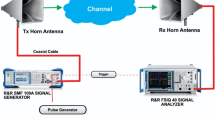Abstract
This paper analyzes the propagation characteristics of the millimeter wave in various circular section tunnels. The received power, path loss and delay spread are discussed in detail using the verified software of Wireless InSite. The investigated tunnel models with circular section include the long straight tunnel, the tunnel with train inside and the curved tunnels with different curvature. The simulated results are verified by the experimental value in the actual tunnel. Several valuable conclusions are obtained, which would offer theoretical and practical references for the millimeter wave communication in limited spaces.









Similar content being viewed by others
References
A. Ama, F. Ohkubo and M. Ida, et al., Millimeter-wave ad-hoc wireless access system-propagation characteristics in indoor environments. Wireless Communication Technol., 2003. IEEE Topical Conference 316–317 (2003), Oct.
S. Collonge, G. Zaharia and G. El Zein., Influence of the human activity on the propagation characteristics of 60 GHz indoor channels. Veh. Technol. Conf., VTC. 1, 251–255 (2003), April, 2003—Spring.
D. Pozar, Microwave Engineering, John Wiley & Sons, Chapter 1, (1998).
L. Martine and D. Pierre, Propagation in Wide Tunnels at 2 GHz: A Statistical Analysis. IEEE Trans. Veh. Technol. Vol.47(4), 1322–1328 (1998).
M. Lienard, S. Betrencourt and P. Degauque, Theoretical and Experimental Approach of the Propagation at 2.5 GHz and 10 GHz in Straight and Curved Tunnels, Veh. Technol. Conf., Vol.4, 2268–2271 (1999), Sept.
P. Mariage, M. Lienard and P. Degauque, Theoretical and experimental approach of the propagation of high frequency waves in road tunnels, IEEE Trans. Antenna Propag., Vol. 42(1), 75–81 (1994).
S. Zhang, Tent law and modeling of radio digital communication channel in tunnel, Journ. Communications (in chinese), Vol.23(11), 41–50 (2002).
S. Naruniranat, Y. Huang and D. Parsons, A Three-dimensional Image Ray Tracing(3D-IRT) Method for Indoor Wireless Channel Characterisation. 1999 High Frequency Postgraduate Student Colloquium, 62–67, (1999), Sep.
M. P. Fernando, J. Francisco and J. Ponce et al., J. Analysis of Path Loss and Delay Spread at 900 MHz and 2.1 GHz While Entering Tunnels. IEEE Trans. Veh. Technol. Vol.50(3), 767–775 (2001).
Acknowledgments
This work was supported by the Shanghai Leading Academic Discipline Project T0102.
Author information
Authors and Affiliations
Corresponding author
Rights and permissions
About this article
Cite this article
Yang, X., Lu, Y. Research on Propagation Characteristics of Millimeter Wave in Tunnels. Int J Infrared Milli Waves 28, 901–909 (2007). https://doi.org/10.1007/s10762-007-9268-y
Received:
Accepted:
Published:
Issue Date:
DOI: https://doi.org/10.1007/s10762-007-9268-y




